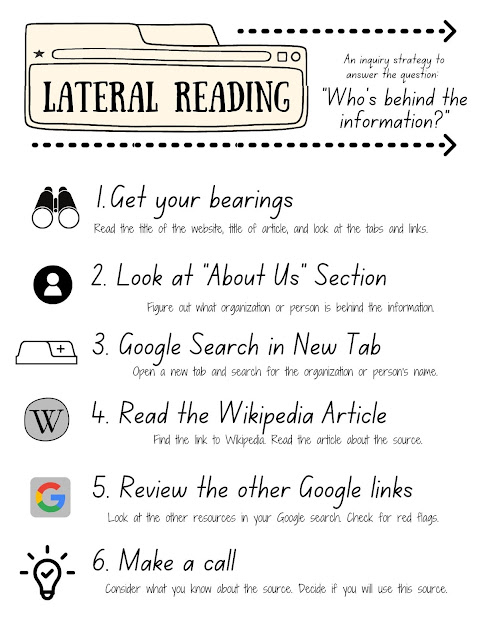Teaching Lateral Reading
Hands down, lateral reading is my FAVORITE strategy for evaluating sources. It's concise, it's super practical, and it's accurate. It can be used for websites AND social media sources. It's also the strategy endorsed by the Stanford History Education Group (SHEG) in their Online Civic Reasoning framework. Here's a link to their collection of lessons for teaching lateral reading. There's also a Crash Course video on YouTube introducing the skill.
To apply lateral reading, you Google the name of a source, then look at the results to see what OTHER sources have to say about your original source. It's called lateral reading because, instead of reading vertically (scrolling down the original website), you open new tabs in your browser to see what other sources say (reading laterally across your browser).
Once you spend some time with lateral reading, it becomes a really organic process, but I've found that students need distinct steps when they're first beginning. Here's the process I use to scaffold the skill with students:





Hello A Bee! I'm a librarian at Boise State University, and we're all big fans here. We would love to use your How to Read Laterally Tik Tok video (https://www.tiktok.com/@bee_in_the_library/video/7052430272150719790) in a module about AI for undergraduate students, but the State of Idaho has forbidden the use of Tik Tok at state agencies. Would you possibly be willing to share your video either in YouTube (or another video hosting site) or with us as a file that we can upload into our university software? We would happily give you attribution. My work email address is elliedworak@boisestate.edu. Looking forward to hearing from you.
ReplyDeleteHello Bee, I love your video on lateral reading and would like to use with attribution for a class. Is there by chance a captioned version available? We close caption everything to accommodate students with hearing issues. Alternatively, are you comfortable with me downloading it and adding captions?
ReplyDeleteHi Karen, sure! You can use it with attribution. You’re fine to download and add captions. Enjoy!
DeleteThank you, Lindsay!
Delete